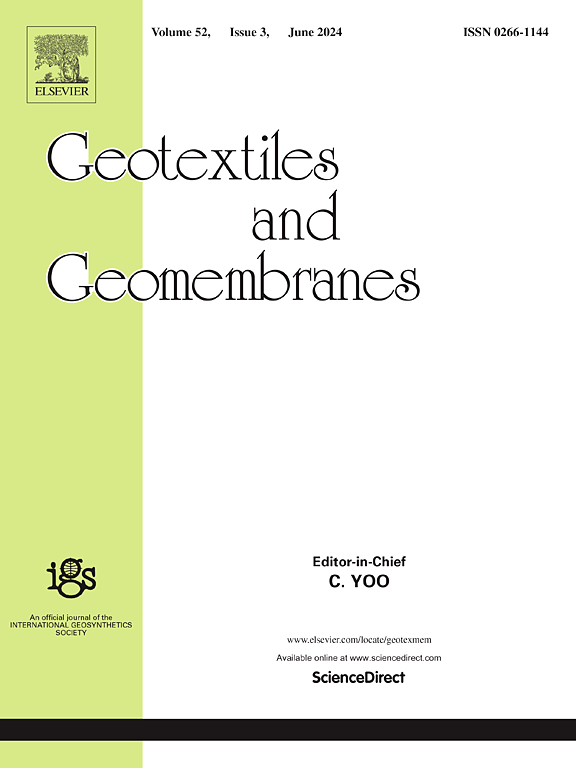空隙上方土工格栅加固土体的变形和破坏机理试验研究
IF 6.2
1区 工程技术
Q1 ENGINEERING, GEOLOGICAL
引用次数: 0
摘要
土工合成材料对于加固地下空隙上的土壤至关重要。然而,加固结构中荷载传递机制的复杂性仍然难以捉摸。本研究利用活门实验研究了土工格栅加固土壤的变形和破坏机制。利用粒子图像测速仪(PIV)技术对土壤变形进行了详细观测,同时使用光纤应变传感电缆监测土工格栅内的拉伸应变。结果表明,土壤拱起重新分配了整个活门区域的荷载,有效地将荷载从下沉区域转移到邻近的稳定区域。随着活门位移的增加,最初的土拱坍塌,促使另一个稳定的土拱形成。土拱的形成和破坏循环往复,直到剪切带到达地表。土拱在较浅的空隙处更容易破坏。应变数据显示,土工格栅的拉力随拉伸应变而变化,在空隙边缘附近拉力最大。对于较浅的空隙,土工格栅的拉伸膜效应承担了更多的上覆土壤重量,而对于较深的空隙,土壤拱起在荷载传递中起着更重要的作用。这项研究为了解土壤拱起和拉伸膜效应之间的相互作用提供了重要的见解,为优化土工合成材料的设计提供了潜在的影响。本文章由计算机程序翻译,如有差异,请以英文原文为准。
Experimental study on deformation and failure mechanism of geogrid-reinforced soil above voids
Geosynthetic materials are crucial for reinforcing soil above subterranean voids. However, the complexities of load transfer mechanisms in reinforced structures remain elusive. This study investigates the deformation and failure mechanisms in geogrid-reinforced soil using trapdoor experiments. The particle image velocimetry (PIV) technique was utilized for detailed observation of soil deformation, while fiber optic strain sensing cables were used to monitor tensile strains within geogrids. Results indicate that soil arching redistributes loads across the trapdoor area, effectively transferring loads from subsiding to adjacent stable regions. As trapdoor displacement increases, the initial soil arch collapses, prompting the formation of another stable arch. This cycle of development and failure of soil arch continues until shear bands reach the ground surface. Soil arches are more prone to failure over shallower voids. Strain data reveal that the geogrid's tension varies with the tensile strain and is highest near the void's edges. For shallow voids, the tensioned membrane effect of the geogrid bears more of the overlying soil weight, whereas for deeper voids, soil arching plays a more significant role in load transfer. This study provides important insights into the interaction between soil arching and tensioned membrane effects, offering potential implications for optimizing geosynthetic design.
求助全文
通过发布文献求助,成功后即可免费获取论文全文。
去求助
来源期刊

Geotextiles and Geomembranes
地学-地球科学综合
CiteScore
9.50
自引率
21.20%
发文量
111
审稿时长
59 days
期刊介绍:
The range of products and their applications has expanded rapidly over the last decade with geotextiles and geomembranes being specified world wide. This rapid growth is paralleled by a virtual explosion of technology. Current reference books and even manufacturers' sponsored publications tend to date very quickly and the need for a vehicle to bring together and discuss the growing body of technology now available has become evident.
Geotextiles and Geomembranes fills this need and provides a forum for the dissemination of information amongst research workers, designers, users and manufacturers. By providing a growing fund of information the journal increases general awareness, prompts further research and assists in the establishment of international codes and regulations.
 求助内容:
求助内容: 应助结果提醒方式:
应助结果提醒方式:


